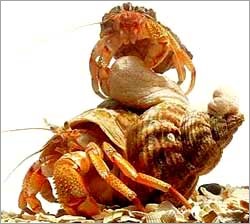DK Nature: Crustaceans
These invertebrates include crabs, barnacles, KRILL, and woodlice. They are sometimes called the insects of the sea, because they are the most numerous ocean arthropods. All crustaceans have hard skin, gills, and two pairs of antennae.

These creatures wear empty mollusk shells for protection from predators. When they outgrow one shell, they simply move into another.
Most crustaceans live in the ocean—although some species live in freshwater, and woodlice and a few crabs live on land. Prawns and shrimp swim freely in open water. Barnacles live attached to rocks, harbor walls, or the sides of ships.
Many crustaceans are scavengers, feeding on scraps and dead creatures. Crabs, shrimp, and prawns search for food mainly at night and hide in crevices by day. Some crabs and lobsters are active predators, seizing prey in their powerful claws. Barnacles filter tiny creatures from the water using their hairy legs. Woodlice munch on plant remains.
Most crustaceans hatch from eggs into nauplius larvae, which do not resemble their adult form at all. These tiny creatures float near the ocean surface, where they feed and grow. They shed their hard skin several times before becoming adults.
Crustaceans make up the second-largest class in the animal kingdom. They include about 38,000 species, split into eight sub-classes:
| Lobsters, crabs, prawns, shrimp, and woodlice |
| Barnacles |
| Seed shrimp |
| Fish lice |
| Copepods |
| Branchiopods |
| Cephalocarids |
| Mystacocarids |
Krill are small, pinkish, shrimplike creatures found in the oceans in huge numbers. They form an important part of the marine food chain and are the main diet of many larger sea creatures.
Krill feed on plankton—tiny plants and animal larvae (young) that float with the ocean currents. They, in turn, are eaten by everything from penguins to whales. Some whales migrate thousands of miles from warmer waters just to feed on seasonal swarms of krill.
Krill are extremely numerous and there is no threat of their dying out. However, they are being taken from the ocean in increasing amounts by fishermen. As krill disappear, the animals that feed on them suffer. Krill trawling in the Antarctic has had a major effect on penguin numbers.

